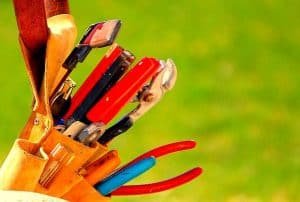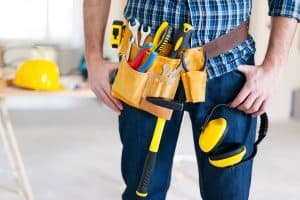A tool belt is an essential part of any construction worker’s attire. The pockets and loops allow the wearer to have their tools on hand in the most convenient way possible, saving them time as they go about completing tasks like demolition or repair work.
Depending on what you need it for, you can wear a tool belt at several different locations around your body. From slung over one shoulder to worn across both shoulders, it can even be worn back-to-front if required.
It doesn’t matter where exactly your tool belt is placed, but make sure that it fits snugly enough not to slip off when you’re moving quickly between areas during busy periods. This will prevent anyone from being injured by tripping over loose straps or trying to avoid heavy machineries like bulldozers and excavators.
What Is A Tool Belt?

A tool belt is a handy way to transport your tools safely and hands-free. Tool belts are perfect for any professional who needs both hands free simultaneously, but who still wants easy access to all of their materials.
In today’s workplace environment, where everyone can telecommute from home with just an internet connection, it might not seem as important. However, some tasks require two people working together on-site. Having a tool belt will ensure you’re always ready to go!
Does Wearing A Tool Belt Cause Back And Shoulder Pain?
Wearing a tool belt on your shoulders day-in and day-out can cause health problems.
Ideally, if you’ll be wearing the shoulder tool belt every working day, try to buy yourself an additional bag. This way, things are more organized, and lightweight tools will take up less space and be less abrasive on the body.
Wearing a tool belt won’t cause you pain or back issues if you wear the tool belt with soft straps and suspenders. Doing so makes carrying the weight easier, putting less strain on your body.
How Do You Wear It?
The tool belt is a necessity for any man who’s handy around the house too. But before you go out and buy one, several points should be addressed.
-
Check The Belt Before Wearing It
Every artisan needs a good tool belt to help them carry all of their tools. Before you purchase a new one, you should scrutinize the leather for any damage or worn spots where there could be potential tears and holes in the future.
Check if anything on the belt is rusty or has patches from wear-and-tear; fix these issues before using it, as it may not be able to serve its purpose anymore.
Because each individual has different weight preferences when carrying items, make sure your belt can accommodate your needs by making adjustments accordingly.
-
Arrange The Tools According To Their Value
The best way to organize your tool belt is by considering your own habits and how you plan to use it. For example, are you left or right-handed? This plays a part in how you should wear your tool belt.
Always set your main pocket on the opposite side of the area you’ll be working in. Make sure that you have easy access to it and that nothing else is in the way. This will prevent any complications while you’re working.
Make use of all the pockets and buckles. Everything should be clipped and strapped appropriately. Doing so guarantees nothing can fall out if you’re moving around quickly!
You should organize the tools in your belt according to their use. There are different pockets for the tools, depending on their priority and frequency of usage.
The first pocket is where you put your frequently used tools, while less used ones can go in other pockets with a little more space, such as in the hooks or locks on the side.
Putting heavy-duty items, such as a hammer, near your waist makes it easier to reach them when they’re needed. This also saves time, allowing you to move quickly.
-
Distribute The Tools According To Their Mass

Maintain a proper balance of belts, pouches, and hooks; distribute the tools evenly so that the weight remains balanced as well.
Craftsmen wear tool belts for long periods of time, so uneven weight can cause pain on the back and shoulders.
A framer’s tool belt consists of many different tools that should be distributed according to their mass too. Otherwise, there will be more pressure put onto the shoulders than other parts of the body, such as the hips.
The small pockets near the front are where nails and other tiny parts go, but these need lids or the straps to be closed tightly so they do not fall out when you’re moving around and bending over.
-
Wear The Belt Properly
Your tool belt is now ready for you to use. It should be worn like a regular belt and tightened enough so that it doesn’t give you any discomfort. However, it shouldn’t be too tight either.
Wrap Up
A tool belt is a necessity for every professional tradesperson. It helps you do your work smoothly and accurately with all of the necessary tools on hand. With a tool belt, you can complete tasks promptly and to perfection.
If you are looking for a tool belt to help complete your tasks more efficiently, then it might be time that you invested in one. Without the right tools on hand at all times, you’ll be climbing up and down ladders to reach what you need, a task that can become very frustrating when you’re trying to get important jobs done.
A craftsman not wearing a tool belt not only works slow, but also the completion of the job within the given deadline becomes more difficult. This can lead to a wastage of time, energy, and effort. A well-organized $30 tool belt, with the right tools, lets you work more efficiently and safely on ladders and other forms of equipment.
To ensure quality results without sacrificing speed or efficiency, tool belts should be a must-have for every craftsman.


